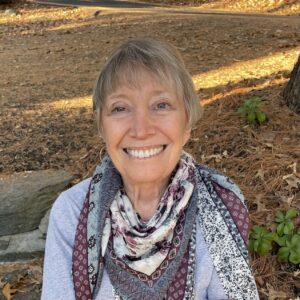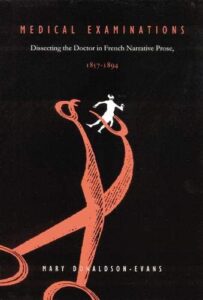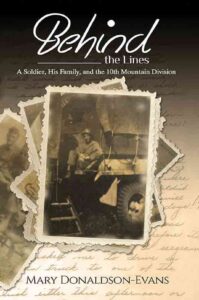
A Conversation with Mary Donaldson-Evans
Lowestoft Chronicle interview by Nicholas Litchfield (November 2022)

During a distinguished academic career, in which she was awarded a chaired professorship, received prominent teaching awards, and was named, “Chevalier” of l’Association des Membres de l’Ordre des Palmes Académiques, Mary Donaldson-Evans drew praise for her many scholarly essays on 19th-century French literature and culture. Her extensive examinations of the work of Guy de Maupassant, which began in the late 1970s, include the book A Woman’s Revenge, which led academics to view her as a connoisseur of Maupassant’s work. Recently, her biographical book, Behind the Lines, attracted warm reviews for its exploration of the era’s social and historical circumstances and the hardships and personal sacrifices of military families and was named a 2022 Distinguished Favorite by the Independent Press Award.
In this exclusive interview with Lowestoft Chronicle, Donaldson-Evans discusses her father’s deployment in Italy during WW2 and reveals her fascination with Maupassant and nineteenth-century French literature, the motivations behind her books, and future literary projects.
Lowestoft Chronicle (LC): Was A Woman’s Revenge: The Chronology of Dispossession in Maupassant’s Fiction your first published book? What is the backstory on how you came to publish this through French Forum Publishers?
Mary Donaldson-Evans (MDE): The editors of French Forum Monographs, Raymond and Virginia La Charité, also published a professional journal, French Forum, and it was there that I placed my very first article, which happened to be on Maupassant. Since they had welcomed my contribution to the journal, it made sense for me to submit my book to their monograph series. I had not tried my luck anywhere else, and I was thrilled when they accepted it.
LC: The book received high praise in academic circles, garnering many positive reviews. In fact, Allan H. Pasco, a distinguished Professor of Nineteenth-Century Literature, who considered you “one of the United States’ best readers of Maupassant,” asserted: “Donaldson-Evans has added considerably to our understanding of the Maupassantian universe.” When did you first develop an interest in Guy de Maupassant, and why? Is it fair to say that your numerous essays on him and the extensive, learned author entry you contributed to the Dictionary of Literary Biography suggest you strived to become an authority on his work?
MDE: As a PhD student in the University of Pennsylvania’s Romance Languages Department, I knew early on that I wanted to write my dissertation on nineteenth-century French literature. The late Frank Paul Bowman, an eminent scholar, was one of two specialists in the nineteenth century, and I approached him to see if he had suggestions for topics worth pursuing. He immediately mentioned Maupassant. I was appalled because, at the time, Maupassant was widely considered to be an author for adolescents, someone you put aside as you matured. This stemmed partly from the fact that his most successful genre was the short story, considered to be inferior to the novel. Now Professor Bowman used to say of his weaker students, “Well, we can’t get any more blood out of that turnip,” and when he proposed that I consider writing my thesis on Maupassant, I interpreted his suggestion as proof positive that he saw me as one of his “turnips.” Nevertheless, I did begin to familiarize myself more thoroughly with Maupassant’s work, and the more I read, the more I became convinced that there was more depth to his fiction than scholars realized. I wrote my thesis on Maupassant under the direction of Professor Bowman…and the rest, I guess, is history. At the time, most of the critics who chose to write on Maupassant—in France and elsewhere—focused on his biography, and particularly on the more lurid aspects of his life, for he was an impenitent womanizer. Apart from Edward Sullivan of Princeton University and Artine Artinian of Bard College, few American critics were actually examining the work. I didn’t set out to be a Maupassant scholar as such, but once I got started, I found his stories and novels a very rich mine to explore.

LC: In Medical Examinations, you expose the textual duplicity in the narratives of late-nineteenth-century antimedical French literature—specifically, you study physician-characters and physician-narrators. A wonderfully precise scope and a fascinating study but quite a challenge to write, I should imagine. What made you research this unusual subject? Was it a challenge omitting works, or was the greater challenge finding eight suitable works?
MDE: I loved that project, and I learned a lot about nineteenth-century medical practice in researching it. I guess the impetus for that study came from my realization that nineteenth-century French literature was rich in depictions of physicians and that they were often portrayed as inept bumblers or downright charlatans. Charles Bovary is a case in point. I set out to find out why this was the case. Surely it was not coincidental that many writers of the era were victims of diseases for which there was, at the time, no cure. Maupassant offers a prime example here, as he was suffering the effects of syphilis for much of his adult life and succumbed to the illness at the age of 43. The challenge was in narrowing my scope. There were abundant examples from the fiction of the period.
LC: Your subsequent book, Madame Bovary at the Movies, an extensive study of twentieth-century film (specifically, the screen adaptations of Madame Bovary)—“an indispensable study” according to Professor Colin Davis—stemmed from an essay you contributed fourteen years earlier to the textbook Approaches to Teaching Flaubert’s Madame Bovary (Approaches to Teaching World Literature). What compelled you to write about film theory? Were you approached by a publisher to write this book, or did positive responses to “Teaching Madame Bovary through Film” encourage you to explore the topic in more detail?
MDE: Madame Bovary at the Movies was the third authored book of my academic career, and yes, it’s true that my teaching informed my scholarship. We were pressured to boost enrollments in foreign languages, and one popular way to do so was to offer courses on film. We were also encouraged to teach foreign literature courses in translation. I designed a course on the nineteenth-century French novel through film, in which students read five well-known novels in English translation and, after each reading, watched a film based on the novel, and it was very enlightening to hear students discuss what novels could do that films couldn’t and vice versa (to paraphrase the title of an article by film critic Seymour Chatman). It was around that time that I learned how popular Madame Bovary had been with filmmakers throughout the world, thanks to its pre-cinematic techniques (Flaubert’s propensity for “showing” rather than “telling”) and one thing led to another and, well, the book came out of that. There were over 18 adaptations of the novel, from several different countries and starting in the silent era, and I learned a lot about filmmaking simply by comparing and contextualizing them.
LC: As an expert on Maupassant, it begs the question: why not also analyze screen adaptations of Maupassant’s works? In The New Yorker, Richard Brody writes: “Maupassant’s stories are so cinematically fruitful because their loose ends invite adaptation and render even methodically faithful adaptations overtly interpretive.” In light of the fact that Maupassant’s hundreds of stories inspired many film and TV adaptations, did you consider analyzing the reception of some of his films?
MDE: Great question! This is something I would probably have considered doing had I remained in academe, but by the time I finished the book on the Bovary adaptations (published in 2009), I was winding down. I had accepted to do a critical edition of Maupassant’s Bel-Ami for the French publisher Garnier towards the end of my career, and all my remaining energy went into that. For reasons beyond my control, that book never appeared (if I were an optimist, I’d say “has not yet appeared”), but that’s another story.

LC: Behind the Lines is an engrossing account of your parent’s life in the 1940s while your father was stationed in Italy during WW2. Actually, a book critic in Kirkus Reviews put it better, eloquently describing it as a heartfelt examination of “the work and worry that filled the lives of wartime families and the sacrifices they undertook for those they loved.” As you sifted through your father’s vast WW2 memorabilia (which apparently consisted of hundreds of exchanges between family and friends), was there a particular moment, a letter perhaps, that made you want to share his and your mother’s memoirs with a broader audience?
MDE: Honestly, my brother Chuck and I (because he’s the one who found the letters in the first place) were like kids in a toy shop when we opened that battered trunk and started reading those musty old letters. It was a “Back to the Future” moment, discovering our parents as they were as young marrieds. There was no particular letter that triggered the desire to publish a book based on this correspondence, simply a sense that we had a story worth telling here. Chuck left the project in my hands.
LC: In fact, Chuck contributes an interesting chapter towards the end of the book and might have featured more had he been able to join you on your Italy trip. Did you discuss chapter ideas with him while writing the book?
MDE: Absolutely! He gave me advice all the way through and was one of my first editors, along with his wife, Gail, and of course, my husband, Lance, who was my very first reader. Chuck has a wicked sense of humor, and he had initially suggested I entitle the book Letters from the Rear, but we thought better of it. I should add that my kids and their spouses also had important roles in the book’s production. My daughter, a professional editor, was especially helpful; my son, an architect, designed the cover.
LC: WW2 narratives hold special appeal, but as you stated in your book, the focus here is not on military battles but “small acts of personal sacrifice” and the “insecurities and fears of wives left to fend for themselves at home.” You had initial concerns about whether this volume would be a worthwhile addition to the legions of war memoirs already in print. Was there also a fear that this project shouldn’t be a public work, that the correspondence between your parents was a private matter that ought to be confined to the family circle?
MDE: Certainly! This is something that all memoir-writers struggle with, and the book shuttles back and forth between history and memoir, exposing my parents’ foibles in a way that might be embarrassing to them were they still alive. On balance, though, I think their humanity and their courage carry the day, and I’ve been gratified to hear readers tell me that they found my parents admirable. Above all, I wanted to describe the life of an ordnance soldier, and not just any ordnance soldier but one who was lucky enough to be assigned to the prestigious 10th Mountain Division. My dad’s experiences, and those of my mom back home, reveal the challenges of what is now a bygone era.
LC: The sheer scale of work involved in reading, editing, and arranging the mass of letters must have been immense, and your careful research on the 10th Mountain Division and interesting but more obscure WW2 details are evident. How does this book compare with your academic books in terms of composition and research effort?
MDE: My academic books required hours and hours of library research. While I read perhaps 30 books in preparing Behind the Lines, much of my research was facilitated by the Internet. Admittedly, this would probably also be true today of academic research. The mental effort required to analyze literary texts was no doubt greater than the mental effort I expended here, but this was offset by the need to acquaint myself with WW2 history. I had been woefully ignorant of this era before I set to work on this book. As for composition, I would say that I had an easier time in the writing of this book than I had with scholarly articles and books. My thesis advisor (him again!) once told me that my style was “too chatty for the honorable genre of the PhD thesis” and I struggled to give more sophistication to my prose. That wasn’t an issue here. For one thing, my thesis director, like my parents, is long gone (May They Rest in Peace). For another, I was hoping the book would appeal to a wider readership than had been the case with my academic writing, and a chattier style seemed appropriate.
LC: Ultimately, what might have become a mundane account of army life and everyday family frustrations is, instead, a rewarding examination of the era, enlivened by observations on things like teeth and tobacco, religion and rationing, and paper and Parker pens. In fact, your research takes you as far as Italy, following in your father’s footsteps. How did your battlefield trip to Italy come about, and how important was it for you to see the places your father was stationed? Was this 2017 pilgrimage undertaken to help write the book?
MDE: (I like your alliteration!) I blush to admit that I had known nothing of the 10th Mountain Division before embarking on this project. I was aware that my father had served during the Second World War, that he had been sent to Italy, and that he had brought a doll home for me. And that was it. However, once I learned about this amazing unit, I joined the descendants’ organization and proudly displayed a sticker on the bumper of my car. How not to succumb to the temptation to join the battlefields tour that was being arranged by the organization? While the pilgrimage was not exactly undertaken to help write the book, it certainly played a role in the whole “immersion” experience and provided me with material for the book’s last chapter. My husband Lance accompanied me. Before we left, he had used his internet skills to put me in touch with an Italian family from Cividale who had befriended my father as the war was ending. Not the least of the thrills of the trip was meeting a woman of 80 who had fond memories of my father’s visits to her home when she was a child. But yes, seeing the hill towns where my father had been stationed was also very moving. I quite literally felt his presence during the tour, and writing a book about his experiences—and my own—seemed not just appropriate but necessary.
LC: For the past ten or more years, you’ve concentrated on short fiction and memoirs, appearing in numerous literary journals—your travel exploits even show up in a column in The New York Times. Are you working towards a collection of travel essays or a story collection? What are your next literary goals?
MDE: This is a tough question to answer. I had not actually thought of gathering my travel pieces for publication as a book, but you’ve given me an idea! I do have two projects underway. The first involves assembling the many memoir-type pieces I’ve written over the years about various aspects of aging. That sounds depressing, I know, but they’re mostly light-hearted and anecdotal rather than profound and probing. Everybody can relate, I think, as we’ve all had moments when we become acutely aware of our advancing years, whether it be that mental lapse that makes us fear Alzheimer’s or the sobering moment when we spy our reflection in the window of a car door. I’m having lots of fun putting these essays together. The other writing project is based on a detailed record of dinner parties that I’ve been keeping since 1972. My husband and I used to entertain quite a bit—we’ve slowed down now—and we’ve had some memorable dinner parties, some quite hilarious and successful, others spectacular failures. I’m interspersing narrative with recipes. Time will tell whether I have enough material for a book. I also have a good number of stories, about half of them published, that I could gather for publication in a single volume.
LC: What’s the backstory on your latest piece for Lowestoft Chronicle? Did “Bulkhead Seat” emerge from intensive research on your father for Behind the Lines?
MDE: I never made that connection myself, but who knows? It’s true that I was deeply immersed in the book project when “Bulkhead Seat” was written, and I remember picturing my own dad as I tapped away on my laptop. I actually composed the first draft of that story on an American Airlines flight to Philadelphia from Amsterdam, and yes! I had a bulkhead seat!
About the Author
Once a professor of French literature, Mary Donaldson-Evans came down from the ivory tower in 2011 and hasn’t looked back. Her creative work has been published by the Lowestoft Chronicle, The Literary Hatchet, BoomerLitMag, The Persimmon Tree, and Spank the Carp, among others. She has also written a book based upon her parents’ World War II correspondence: Behind the Lines: A Soldier, His Family and the 10th Mountain Division (Austin-Macauley, 2021).
About the Author
Nicholas Litchfield is the founding editor of Lowestoft Chronicle. He has worked in various countries as a journalist, librarian, and researcher and resides in western New York. Formerly a book critic for the Lancashire Post, syndicated to twenty-five newspapers across the U.K., he now writes for Publishers Weekly and regularly contributes to the Colorado Review. He can be found at nicholaslitchfield.com.
